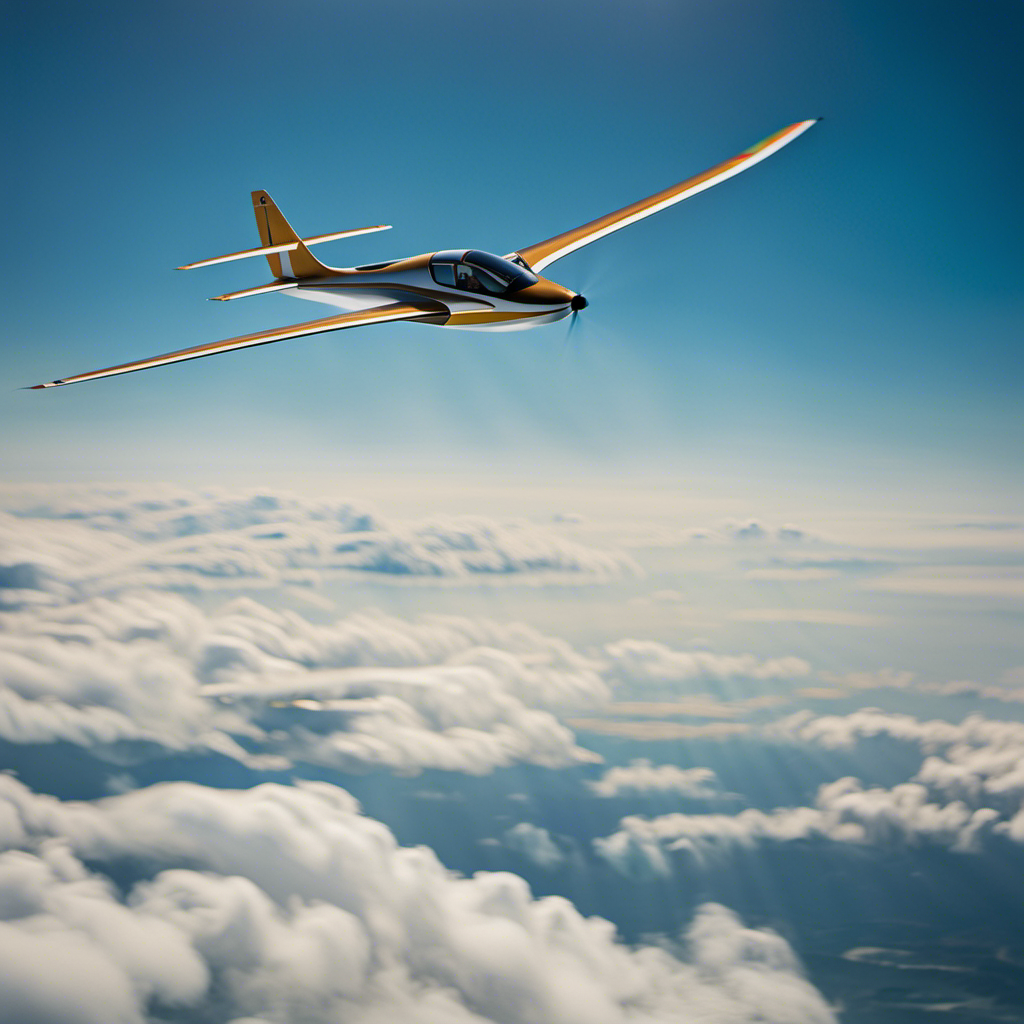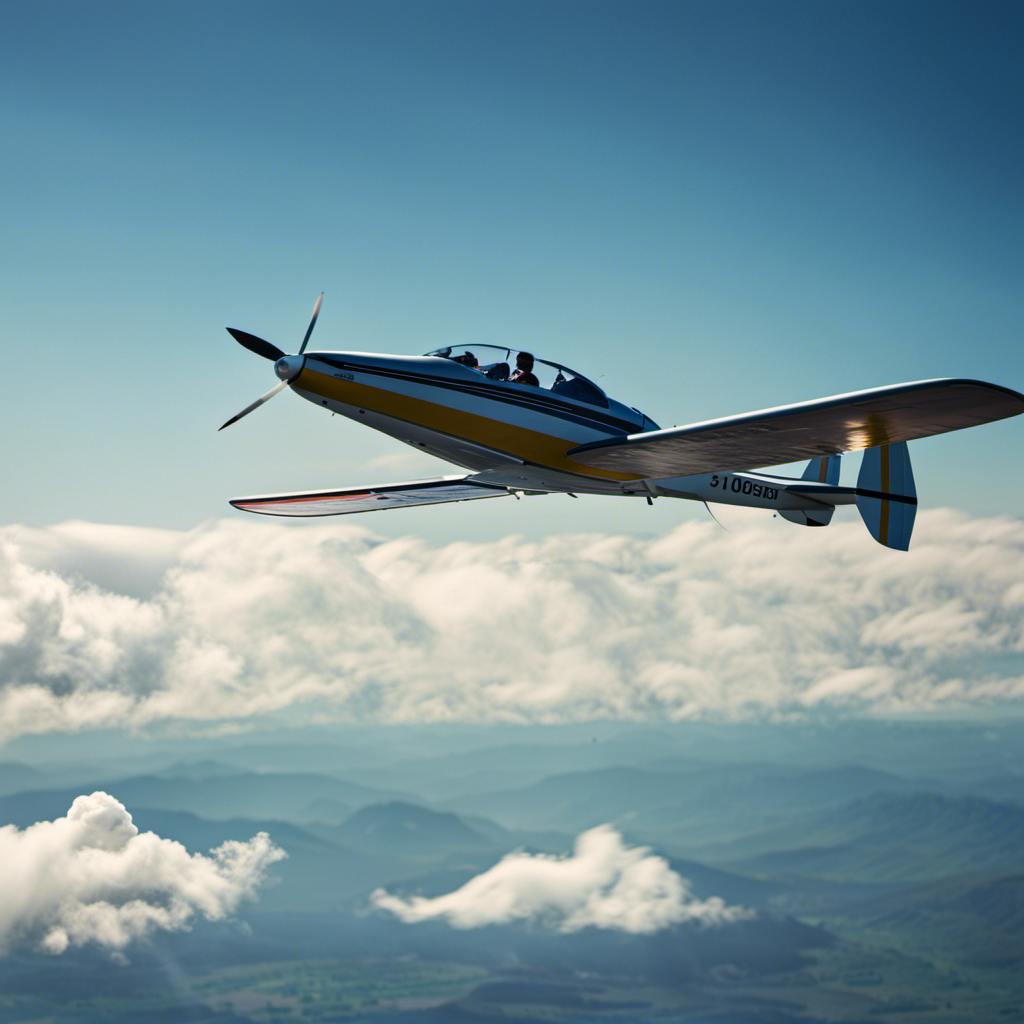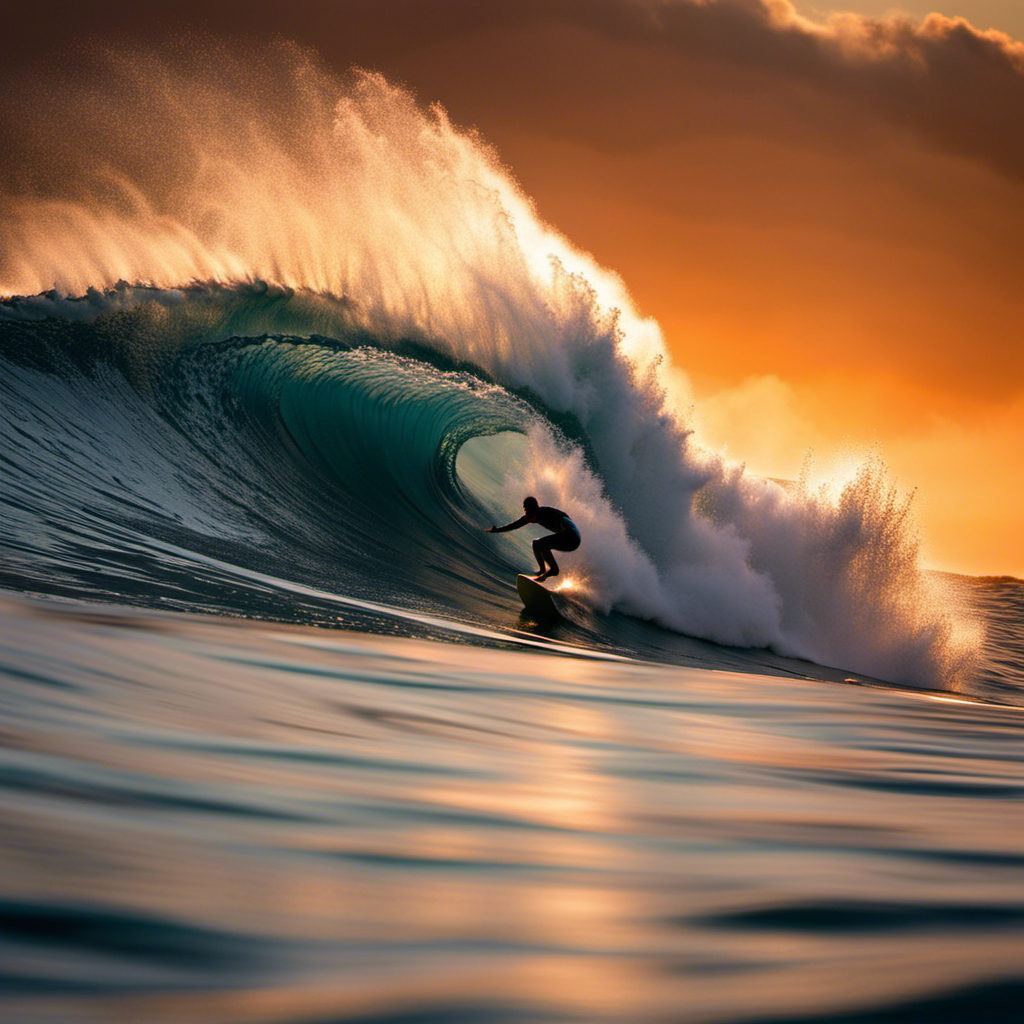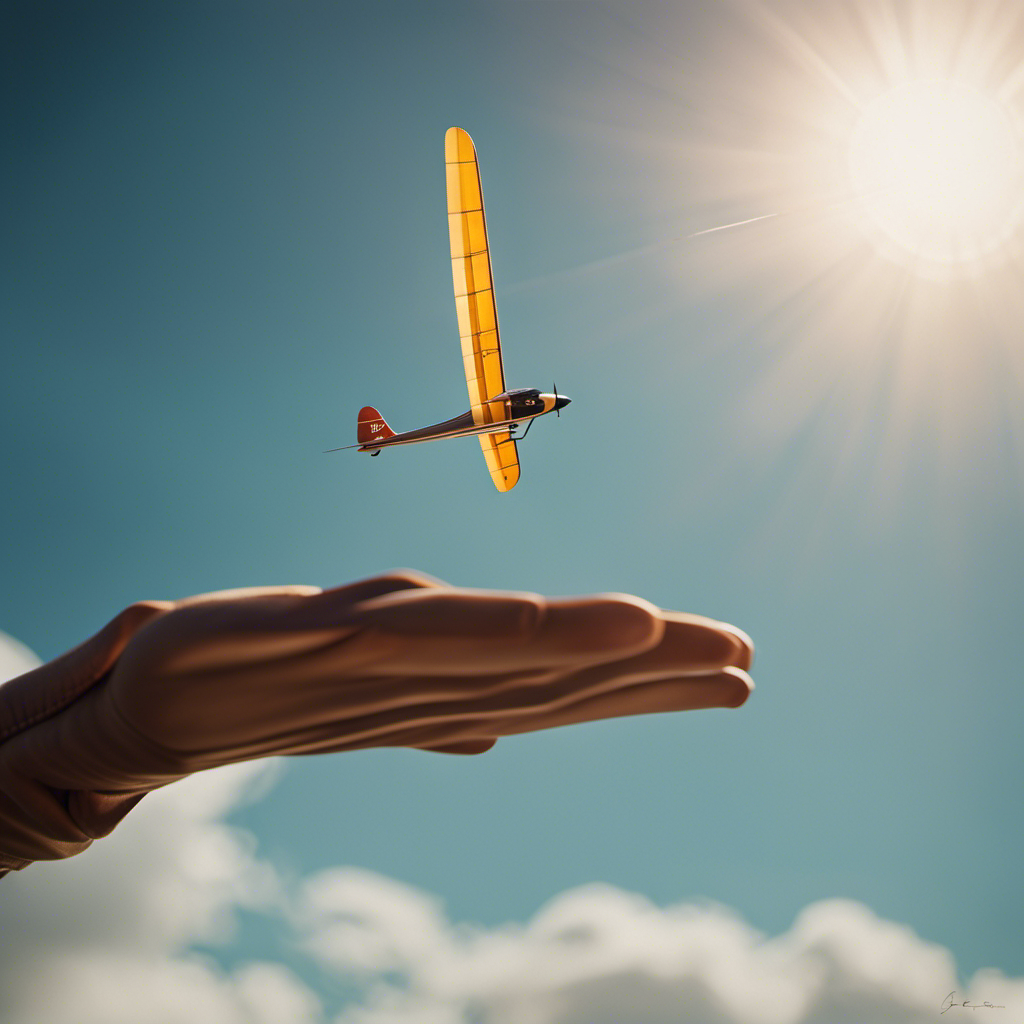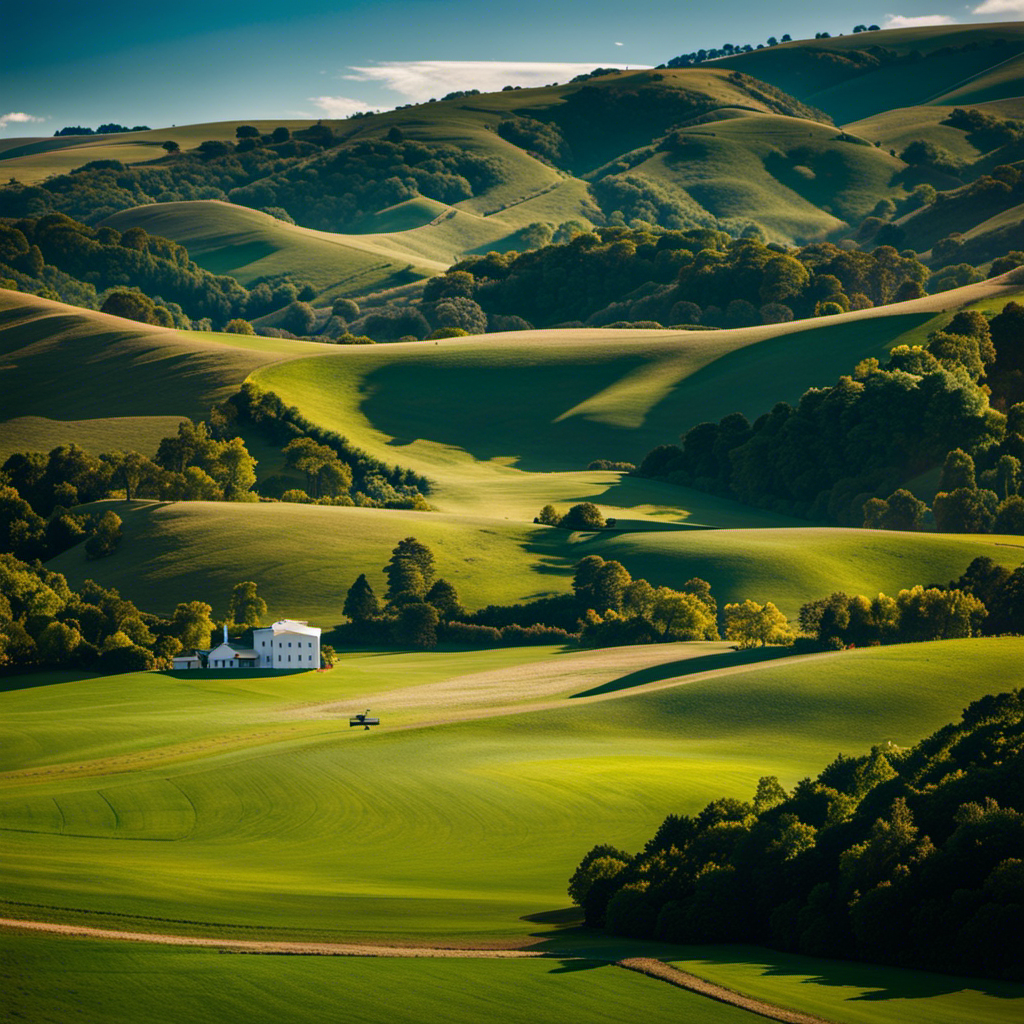I have always been fascinated by glider planes.
Did you know that gliders can stay airborne for hours without an engine?
In this article, we’ll explore the captivating world of glider planes, from their rich history to how they work and the different types available.
We’ll also delve into the exhilaration of glider plane flying, the training required to become a certified pilot, and the exciting competitions and events that take place.
So buckle up and join me on this journey into the thrilling world of glider planes.
Key Takeaways
- Glider planes have a long history and have evolved from being used for recreation and training to becoming popular for competitions.
- Gliders rely on lift and drag for flight, with wings creating a difference in air pressure to generate lift.
- There are different types of glider planes, including traditional gliders, motorized gliders, and high-performance gliders.
- Glider plane flying offers a thrilling and immersive experience, with techniques like ridge soaring and thermal soaring enhancing the thrill.
The History of Glider Planes
The history of glider planes goes back to the early 1900s when they first gained popularity. Glider planes were initially used for recreational purposes and as a means of training for powered flight. However, over time, glider plane competitions started to emerge, providing a platform for pilots to showcase their skills and push the limits of this unique flying machine.
Throughout history, there have been many famous glider plane pilots who have made significant contributions to the development and advancement of this sport. One notable pilot is Otto Lilienthal, often referred to as the ‘Glider King.’ Lilienthal conducted extensive research on the principles of flight and made over 2,000 successful glider flights. His work laid the foundation for modern glider design and inspired future generations of pilots.
Another renowned pilot is Hanna Reitsch, a German aviator who became the first woman to fly a glider plane across the Alps. She was known for her exceptional skills and daring feats, and her contributions to the field of glider aviation were highly influential.
Transitioning into the next section about how glider planes work, it is important to understand the historical context and the notable figures who have shaped this fascinating sport.
How Glider Planes Work
To understand how glider planes work, it’s important to grasp the concept of aerodynamics. Glider planes rely on the principles of lift and drag to stay aloft without the use of an engine. As the glider moves through the air, the shape of its wings creates a difference in air pressure, generating lift. This upward force allows the glider to soar through the sky. The pilot can control the glider’s flight path by adjusting the control surfaces, such as the ailerons and elevator, to change the angle of attack and achieve the desired maneuver.
In glider plane competitions, pilots utilize different soaring techniques to maximize their flight time and distances. One technique is called thermal soaring, where pilots search for rising columns of warm air called thermals. By circling within these thermals, gliders can gain altitude and extend their flight duration.
Another technique is ridge soaring, where pilots fly along the edge of a ridge or mountain, utilizing the updrafts created by the wind hitting the slope. This allows gliders to maintain altitude and cover long distances.
Understanding how glider planes work sets the foundation for exploring the different types of glider planes and their unique characteristics.
Different Types of Glider Planes
When it comes to glider planes, there are three main types that deserve attention: traditional gliders, motorized gliders, and high-performance gliders.
Traditional gliders rely solely on the forces of nature, utilizing air currents and thermals for lift.
Motorized gliders, on the other hand, have an engine that allows them to take off and maintain altitude without the need for a tow or a launch from a hill.
Lastly, high-performance gliders are designed for advanced pilots who seek out the thrill of soaring at faster speeds and performing aerobatic maneuvers.
Traditional Gliders
Glider pilots can enjoy the simplicity and beauty of a traditional glider design. These vintage gliders harken back to the early days of aviation, with their sleek, graceful shapes and reliance on wind currents for flight. These gliders are typically made of lightweight materials like wood and fabric, and they lack any form of motorized propulsion. Instead, they rely on thermals, updrafts, and ridge lift to stay aloft.
As a glider pilot, I find flying these traditional gliders to be a truly exhilarating experience. The feeling of soaring through the air, completely at the mercy of nature, is unmatched. It’s a pure and serene form of flight that allows one to truly connect with the sky.
Now, let’s transition to the next section where we’ll explore motorized gliders.
Motorized Gliders
Motorized gliders offer the convenience of an engine while still allowing pilots to experience the joy of soaring through the sky. These gliders, often referred to as electric gliders, combine the efficiency of a glider with the added power of an electric motor.
With advancements in battery technology, electric gliders have become more popular in recent years. These gliders are typically modified versions of traditional glider planes, with the addition of an electric motor and battery system. The motor provides an extra boost during takeoff and climb, allowing pilots to reach greater altitudes and explore new areas.
Once at a desired altitude, the motor can be switched off, and the glider can continue to soar effortlessly through the air.
Now, let’s delve into the world of high-performance gliders.
High-Performance Gliders
High-performance gliders offer an exhilarating experience for pilots who crave speed and agility in the sky. These cutting-edge aircraft are equipped with advanced glider technology, pushing the boundaries of what is possible in the world of glider plane flying.
Here are three key features that make high-performance gliders stand out:
-
Aerodynamic Design: High-performance gliders are meticulously designed to minimize drag and maximize lift. Every curve and contour is carefully crafted to ensure optimal aerodynamic efficiency, allowing these gliders to achieve impressive speeds and maneuverability.
-
Lightweight Construction: Advanced materials like carbon fiber and fiberglass are used in the construction of high-performance gliders to keep them lightweight yet strong. This enables these gliders to soar effortlessly through the air, responding quickly to pilot input.
-
High Aspect Ratio Wings: High-performance gliders typically have long and slender wings with a high aspect ratio. This design feature helps to reduce induced drag and improve overall glide performance, allowing pilots to cover greater distances with ease.
These features combine to create an unparalleled flying experience, where pilots can feel the rush of the wind as they navigate the skies with precision and grace.
The Thrill of Glider Plane Flying
When it comes to glider plane flying, there are three key aspects that bring an incredible thrill. First, experiencing silent flight. The silence in the cockpit as you glide through the air is both serene and exhilarating, allowing you to fully immerse yourself in the experience.
Second, mastering soaring techniques. Soaring techniques, such as ridge soaring and thermal soaring, enable you to stay aloft for extended periods, harnessing the power of nature. These techniques require skill and precision, as you navigate the currents of air to maintain altitude and explore the skies.
And finally, executing aerobatic maneuvers. For those seeking an extra adrenaline rush, aerobatic maneuvers like loops and spins provide an exciting challenge that pushes the limits of the aircraft and pilot alike. These maneuvers require a combination of skill, coordination, and confidence to execute, adding an element of excitement and thrill to the glider flying experience.
Experiencing Silent Flight
Experiencing silent flight in a glider is truly a unique and peaceful sensation. Gliders, also known as sailplanes, rely on silent flight techniques to stay airborne without the need for an engine. Here are four benefits of glider planes:
-
Serene Environment: Gliders offer a quiet and serene environment, free from the noise and vibration of a traditional engine. The only sounds you’ll hear are the wind whispering past the wings and the occasional chirping of birds.
-
Enhanced Sensory Experience: Without the distraction of engine noise, you can fully immerse yourself in the sights and sounds of nature. You’ll have a heightened awareness of the world below, enjoying breathtaking views and a deep connection with the environment.
-
Energy Efficiency: Glider planes use soaring techniques to harness the energy of rising air currents. By riding these thermals and updrafts, glider pilots can stay aloft for extended periods, maximizing their flight time and minimizing their environmental impact.
-
Skill Development: Glider flying requires a high level of skill and precision. Mastering silent flight techniques and understanding the dynamics of the air enhances your piloting abilities and deepens your understanding of aviation principles.
Transitioning into the subsequent section about soaring techniques, I’ll now delve into the art of harnessing the power of the wind to keep a glider soaring effortlessly.
Soaring Techniques
Transitioning into the subsequent section about soaring techniques, let’s explore how glider pilots use the power of the wind to stay airborne.
Soaring techniques are essential for glider pilots to extend their flight time and cover long distances. One common technique is ridge soaring, where pilots take advantage of winds blowing against hills or mountains. By flying close to the ridge, the glider can ride the upward air currents, known as updrafts, created by the wind hitting the slope.
Another technique is thermal soaring, where pilots seek out areas of warm air rising from the ground. By circling within these thermals, the glider gains altitude and can stay aloft for extended periods. These advanced maneuvers require skill and precision, allowing glider pilots to navigate the skies with grace and efficiency.
As we move into the subsequent section about aerobatic maneuvers, we will explore the thrilling world of high-flying acrobatics.
Aerobatic Maneuvers
Now, let’s dive into the thrilling world of aerobatic maneuvers and discover how you can perform exciting and gravity-defying tricks in the air.
Aerobatic competitions have become a popular sport, showcasing the skills and precision of pilots as they push the limits of their aircraft. To excel in these competitions, rigorous aerobatic training is essential.
Here are some key maneuvers you can learn:
-
Loop: The aircraft climbs vertically, then rotates upside down and descends in a circular path.
-
Roll: The aircraft rotates around its longitudinal axis, creating a barrel roll effect.
-
Spin: The aircraft enters an autorotation, descending rapidly while spinning.
-
Hammerhead: The aircraft climbs vertically, comes to a stop, and then descends vertically.
-
Cubans Eight: A complex maneuver involving two loops and a half-roll between them.
Mastering these maneuvers requires dedication, practice, and a thorough understanding of aerodynamics.
Now, let’s explore the training and certification for glider pilots, where you can take your skills to new heights.
Training and Certification for Glider Pilots
To become a certified glider pilot, you’ll need to complete a comprehensive training program. This program focuses on developing the necessary skills and knowledge to safely operate a glider plane. Training techniques include classroom instruction, flight simulations, and hands-on flying experience. The goal is to ensure that pilots have a solid understanding of aerodynamics, weather patterns, navigation, and emergency procedures.
Pilot qualifications are an essential part of the certification process. These qualifications determine whether a candidate is capable of operating a glider plane safely and responsibly. Some of the requirements include a minimum age, medical fitness, and a certain number of flight hours. Additionally, pilots must pass written exams and demonstrate proficiency in various flight maneuvers.
To provide a clearer understanding of the training process, here is a table outlining some of the key elements:
| Training Technique | Description |
|---|---|
| Classroom Instruction | Covers theoretical knowledge of glider operations |
| Flight Simulations | Allows pilots to practice in a controlled environment |
| Hands-on Flying | Provides real-life flying experience |
| Written Exams | Tests knowledge of regulations and procedures |
By completing this training program and meeting the necessary qualifications, aspiring pilots can acquire the skills and knowledge needed to safely operate a glider plane. With this foundation, they can move on to the next section, which focuses on glider plane safety and maintenance.
Now, let’s delve into the importance of glider plane safety and maintenance.
Glider Plane Safety and Maintenance
When it comes to ensuring the safety and proper functioning of your glider plane, regular maintenance and adherence to safety protocols are crucial. Glider plane safety should always be a top priority for pilots. To maintain the safety and reliability of your aircraft, it is essential to follow best practices in maintenance. This includes conducting regular inspections, performing necessary repairs, and using the right equipment.
One of the key techniques in maintaining a glider plane is conducting thorough inspections. These inspections should cover every aspect of the aircraft, including the airframe, control surfaces, landing gear, and electrical systems. By carefully examining each component, potential issues can be identified and addressed before they escalate into more serious problems.
Repairs should be carried out promptly whenever any issues are detected during inspections or during regular use. It is important to have a thorough understanding of the aircraft’s manual and consult with experts if necessary to ensure repairs are done correctly. By addressing repairs promptly, you can prevent further damage and maintain the overall safety of your glider plane.
In terms of equipment, it is crucial to have the right tools and resources to conduct inspections and repairs effectively. This includes having a comprehensive toolkit, access to technical manuals, and a reliable source for obtaining replacement parts.
Glider Plane Competitions and Events
If you’re interested in participating in glider plane competitions and events, it’s important to familiarize yourself with the rules and regulations governing these activities. Glider plane competitions offer an exhilarating experience for pilots and spectators alike.
Here are some key aspects to consider:
-
Glider Plane Festivals: These events bring together glider plane enthusiasts from around the world. Festivals often feature thrilling aerial displays, acrobatics, and competitions. They provide a unique opportunity to witness the beauty of glider planes in action and connect with fellow enthusiasts.
-
Glider Plane World Records: Glider pilots continually strive to push the boundaries of what’s possible in their sport. World records are frequently set in glider plane competitions, showcasing the incredible skills and capabilities of these aircraft. From longest distance flights to highest altitudes reached, these records inspire pilots to reach new heights.
Attending glider plane festivals and witnessing record-breaking feats can be truly awe-inspiring. But the world of glider planes doesn’t stop there. Beyond competitions and events, there is a vibrant community of glider plane clubs and enthusiasts who come together to share their passion for soaring through the skies.
In the next section, we will explore the importance of these clubs and communities in fostering growth and camaraderie within the glider plane community.
Glider Plane Clubs and Communities
When it comes to joining a glider club, there are numerous benefits to consider. Not only do you get to socialize and network with fellow enthusiasts, but you also get to participate in group flights and activities.
These experiences can greatly enhance your skills and knowledge in the world of glider planes.
Joining a Glider Club
Joining a glider club is a great way to learn how to fly without an engine. Glider club membership offers a range of benefits to aspiring pilots.
First and foremost, it provides access to expert guidance and instruction from experienced glider pilots. These seasoned aviators can teach you the ins and outs of glider flying, from takeoff to landing.
Additionally, glider clubs often have a fleet of glider planes available for rental, allowing you to practice your skills whenever you want. Being part of a glider club also grants you access to specialized facilities and equipment, such as glider maintenance workshops and flight simulators.
Moreover, glider club membership opens doors to socializing and networking with fellow enthusiasts, fostering a sense of camaraderie and shared passion for glider planes. Transitioning into this vibrant community allows you to learn from others, exchange experiences, and forge lasting friendships.
Socializing and Networking with Fellow Enthusiasts
After joining a glider club and immersing myself in the world of soaring, I quickly discovered that it’s not just about the thrill of flying; it’s also about the incredible community that comes with it. Socializing and networking with fellow enthusiasts is an essential part of the glider plane experience.
When you become a member of a glider club, you gain access to a vibrant community of like-minded individuals who share your passion for soaring. Here are five ways in which socializing and networking contribute to the glider plane experience:
- Engaging in lively conversations about the latest glider plane technology and techniques.
- Sharing stories and experiences from exhilarating flights, fostering a sense of camaraderie.
- Attending club events and gatherings where you can meet experienced pilots and learn from their expertise.
- Joining online forums and discussion groups to connect with glider enthusiasts worldwide.
- Collaborating on group projects and initiatives that advance the glider plane community’s knowledge and skills.
With a strong sense of community established through socializing and networking, participating in group flights and activities becomes an integral part of the glider plane experience.
Participating in Group Flights and Activities
Once you become a member of a glider club, participating in group flights and activities allows you to enhance your flying skills while enjoying the company of fellow enthusiasts.
Group flights are a great way to learn from experienced pilots and gain practical knowledge about flying techniques and strategies. You can observe their maneuvers, ask questions, and receive valuable feedback.
Additionally, engaging in glider plane activities such as formation flying and aerobatics can push your limits and improve your overall flying abilities. These activities require precision, coordination, and a deep understanding of the aircraft’s capabilities.
By engaging in group flights and activities, you not only enhance your skills but also foster a sense of camaraderie within the gliding community.
As you gain confidence and expertise, it’s time to explore glider plane destinations and scenic routes, where you can experience the thrill of soaring through breathtaking landscapes.
Glider Plane Destinations and Scenic Routes
There’s nothing quite like soaring through the sky in a glider, taking in the breathtaking views of scenic routes and destinations. Glider plane tourism has become increasingly popular among adventure enthusiasts and photography enthusiasts alike. With its ability to glide silently and smoothly through the air, a glider plane offers a unique and tranquil experience that is unmatched by any other aircraft.
To give you a glimpse of the stunning locations you can explore in a glider, here are some top destinations and scenic routes:
| Destination | Scenic Route | Highlights |
|---|---|---|
| Swiss Alps | Jungfrau | Majestic snow-capped peaks and picturesque valleys |
| Patagonia | Fitz Roy | Towering granite mountains and glacial lakes |
| New Zealand | Southern Alps | Rugged landscapes, fjords, and turquoise lakes |
| Grand Canyon | Dragon Corridor | Spectacular views of the iconic natural wonder |
| Tuscany, Italy | Chianti Region | Rolling hills, vineyards, and charming villages |
Whether you’re capturing stunning aerial photographs or simply enjoying the breathtaking scenery, glider plane tourism offers an unparalleled experience. The silence and lack of engine noise allow for a peaceful and immersive journey, where you can fully appreciate the beauty of these destinations. From the towering peaks of the Swiss Alps to the rugged landscapes of Patagonia, glider plane photography provides a unique perspective that is sure to leave you in awe.
As we explore the future of glider planes, advancements in technology and design hold great promise for even more thrilling and efficient experiences.
The Future of Glider Planes
Advancements in technology and design hold great promise for even more thrilling and efficient experiences in the future of glider planes. As an avid glider pilot, I am excited to see what the future holds for this incredible sport. Here are three future developments that are set to transform the world of glider planes:
-
Electric Propulsion: With the increasing focus on sustainability and reducing environmental impact, electric propulsion systems are being developed for glider planes. These systems will not only minimize noise pollution but also eliminate the need for traditional combustion engines, making gliding even more eco-friendly.
-
Improved Materials: The use of advanced materials, such as carbon fiber composites, will lead to lighter and stronger glider planes. This will enhance their performance and maneuverability, allowing pilots to achieve even greater speeds and perform daring maneuvers with ease.
-
Enhanced Safety Systems: Safety is always a top priority in aviation, and future glider planes will feature even more advanced safety systems. From improved parachute deployment systems to better collision avoidance technology, these advancements will ensure that pilots can enjoy their flights with peace of mind.
With these future developments on the horizon, the world of glider planes is poised for an exciting evolution. Not only will these advancements enhance the overall experience for pilots, but they will also contribute to reducing the environmental impact of this thrilling sport. I can’t wait to see what the future holds for glider planes!
Frequently Asked Questions
What are the benefits of flying glider planes compared to other types of aircraft?
The benefits of flying glider planes compared to other aircraft include their cost-effectiveness, environmental friendliness, and the unique experience of soaring through the air without an engine. Additionally, glider flying is generally considered safe when proper training and precautions are followed.
Are there any age restrictions to fly glider planes?
Age restrictions for flying glider planes vary depending on the country and the specific regulations in place. Safety regulations play a crucial role in determining the minimum age requirements to ensure a safe and responsible flying experience.
Can glider planes be used for long-distance flights?
Glider planes offer impressive fuel efficiency and endurance, making them suitable for long-distance flights. With their aerodynamic design and ability to soar on thermal currents, gliders can stay aloft for hours, allowing for exciting and efficient cross-country journeys.
How do glider pilots navigate and find thermals?
Glider pilots use various techniques to navigate and find thermals, which are pockets of rising air. They rely on visual cues, such as cloud formations and birds, as well as instruments that measure air temperature and wind direction to locate areas of lift.
Are there any limitations or challenges when flying glider planes in certain weather conditions?
Navigating and flying glider planes in certain weather conditions present limitations and challenges. Safety precautions become crucial as weather conditions can impact the stability and performance of the glider, requiring pilots to exercise caution and make informed decisions.
Conclusion
In conclusion, exploring the fascinating world of glider planes has been an eye-opening experience.
From learning about their rich history to understanding how they work, the thrill of glider plane flying is unmatched.
The training and certification process for glider pilots is rigorous, but the rewards are worth it.
Glider plane competitions and events bring together a passionate community of aviators.
As we look to the future, advancements in technology will surely shape the world of glider planes, but the timeless beauty of soaring through the skies will always remain.
So, strap in and let’s take flight into the future of glider planes!
With a heart that soars as high as the skies, Aria, affectionately known as “Skylark,” is the driving force behind Soaring Skyways. Her journey into the gliding world began as a young dreamer gazing up at the soaring birds, yearning to experience the weightlessness and freedom they embodied. With years of experience both in the cockpit and behind the scenes, Aria’s commitment to the gliding community is unwavering.
